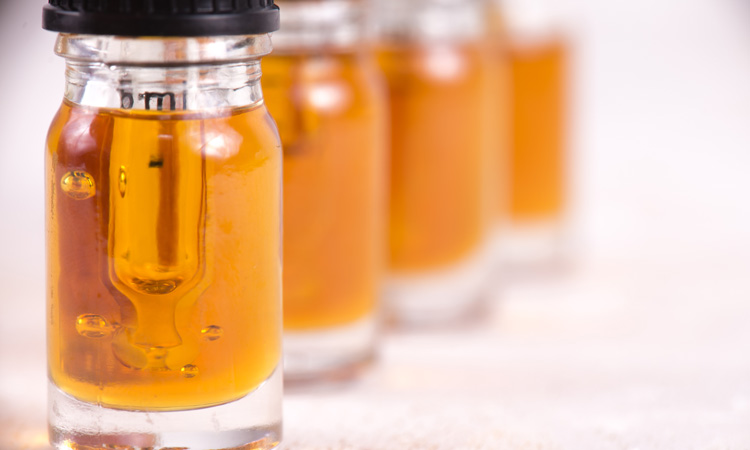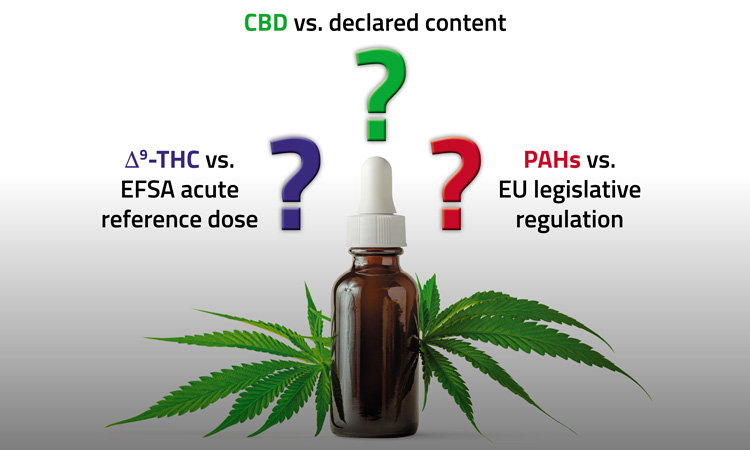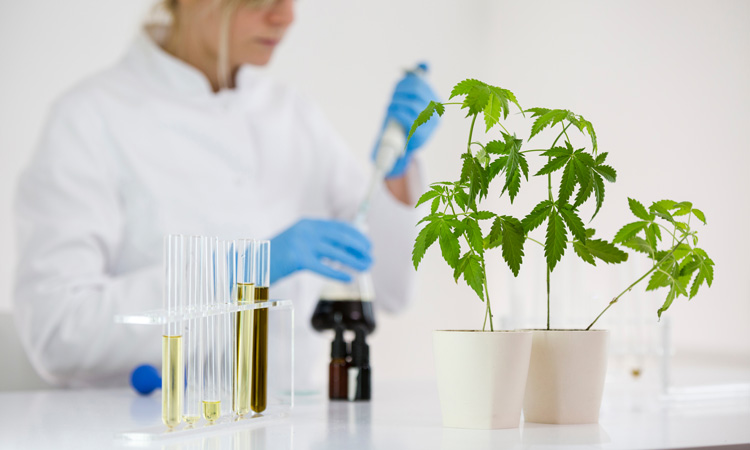Ensuring the safety of THC dosage in CBD oils
- Like
- Digg
- Del
- Tumblr
- VKontakte
- Buffer
- Love This
- Odnoklassniki
- Meneame
- Blogger
- Amazon
- Yahoo Mail
- Gmail
- AOL
- Newsvine
- HackerNews
- Evernote
- MySpace
- Mail.ru
- Viadeo
- Line
- Comments
- Yummly
- SMS
- Viber
- Telegram
- Subscribe
- Skype
- Facebook Messenger
- Kakao
- LiveJournal
- Yammer
- Edgar
- Fintel
- Mix
- Instapaper
- Copy Link
Posted: 20 February 2020 | Frantisek Benes, Marie Fenclova PhD, Petra Peukertova, Professor Dr Jana Hajslova, Zbynek Dzuman PhD, Zuzana Binova | No comments yet
There is debate over whether CBD oils offer health benefits, which can be attributed to its rising popularity. But the assessment of CBD oils is a complex task, particularly due to the potential for oils to contain undeclared traces of delta-9-tetrahydrocannabinol. Six experts from the University of Chemistry and Technology, Prague, present their research.


The popularity of cannabidiol (CBD) oils is growing exponentially owing to their association with numerous health benefits and even miraculous healing properties. However, some CBD oils may also present several problems, especially in terms of their safety, due to the presence of undeclared delta-9-tetrahydrocannabinol (∆9-THC).
Phytocannabinoids
Phytocannabinoids, along with terpenes and terpenoids, are the major biologically active secondary metabolites of Cannabis sativa L., which are being extensively studied due to their potential therapeutic effects. In the cannabis plant, phytocannabinoids commonly occur in the form of carboxylic acids,1 from which neutral forms possessing the desired ‘therapeutic’ effect originate (via decarboxylation). This process is mostly induced by high temperatures.2 However, the ‘activation’ of phytocannabinoid acids is accompanied by a variety of other reactions that can affect the resulting biological activity of Cannabis extracts.3
Over 20 percent of the tested CBD oils contained less CBD than declared by the manufacturer.
The most extensively studied phytocannabinoids are CBD and ∆9-THC. The latter is the main hallucinogenic compound of Cannabis sativa L. and, therefore, is legislatively regulated worldwide as a narcotic substance. Contrary to ∆9-THC, CBD does not exhibit hallucinogenic effects and is currently attributed with having significant therapeutic potential. Its beneficial characteristics include being antiepileptic, antibacterial, antidiabetic, analgesic, anti-inflammatory, immunosuppressive, neuroprotective, antipsychotic and anti-cancer, among many others.1 CBD is also able to reduce the psychotropic effects of ∆9-THC.4
It has long been believed that CBD is completely non-toxic, but according to a warning recently issued by the US Food and Drug Administration (FDA), it can cause liver damage.5 When used as a medicine in cases where patients are under professional medical supervision, this negative effect from CBD can be monitored and avoided. Despite this, there is a wide range of CBD-enriched products (and even pure CBD crystals) freely available on the market, the most popular of which are CBD oils.
When using Cannabis and derived products as a medicine, the presence of several other biologically active compounds besides CBD and ∆9-THC should be considered. According to Russo,3 all these substances are involved in the overall biological effect; the synergic actions of phytocannabinoids and terpenes termed the ‘entourage effect’ play an especially important role. As an example, this was demonstrated on two Cannabis varieties with the same CBD and ∆9-THC content, one of which shows therapeutic effects and the other not.3
CBD oils
Commonly, CBD oils are made of various edible vegetable oils enriched with natural decarboxylated extract of the Cannabis plants (up to 50 percent of extract) or in some cases purified CBD (natural or synthetic) is dissolved in oil.6 There are dozens of such CBD products on the market with contents that vary from tenths to dozens in weight percentage (wt.). Although, in most cases, not declared on the label, CBD oils may contain relatively high levels of ∆9-THC, which may pose a risk for consumers. The other health risk documented in our recent studies is the presence of carcinogenic polycyclic aromatic hydrocarbons (PAHs).7
1. Non-compliance with CBD declaration and alarming content of ∆9-THC
Even Cannabis plants specially bred for high CBD content contain at least trace amount of ∆9-THC. As most isolation procedures – whether supercritical fluid extraction (SFE) or ethanolic extraction – are rather nonselective, all lipophilic cannabis components, including the undesirable ∆9-THC, are substantially concentrated.
If no further purification of CBD is performed, then the psychotropic ∆9-THC content becomes unacceptably high, putting CBD oil consumers at unexpected risk. This includes positive outcomes in drug testing, which could have serious consequences for drivers (ICCI web).
Approximately 60 percent of the tested CBD oils exceeded the legislation limits for PAH levels.
Between 2016 and 2019, the University of Chemistry and Technology in Prague (UCT Prague), under the auspices of the International Cannabis and Cannabinoids Institute (ICCI), analysed 70 CBD oils from EU markets.8,9 More than 20 percent of those CBD oils contained less CBD than declared by the manufacturer. Regarding ∆9-THC content, more than 90 percent of the samples contained this psychotropic compound at a concentration greater than 0.2 weight by weight (w/w) percent (EU legislative limits for dry hemp plants). However, only a few of these products provided information about ∆9-THC occurrence on the label.


These results correspond to the results of a study by Pavlovic et al.;10 in which 14 CBD oils from the European market were analysed, nine of them having a deviation of over 10 percent from the manufacturer’s declared CBD content. Furthermore, 12 out of 14 samples contained hallucinogenic ∆9-THC (0.0036-0.35 wt. percent).10 Some of the tested oils also contained high levels of cannabidiolic acid (CBDA) and the declared CBD content was reported by the manufacturer as [CBD] + 0.877 * [CBDA]. As CBDA is a biologically inactive form of CBD,1 its content in the ready-to-eat product (which is not intended to experience heat treatment, and therefore not expected to produce CBDA decarboxylation before consumption) should not be reflected in the total CBD content. It is worth noting that the European Food Safety Authority (EFSA) has established an acute reference dose (ARfD) of ∆9-THC 1 µg/kg body weight – an amount of ∆9-THC, which can be taken daily without a risk. For an average person weighing 70kg, this dose is 70µg ∆9-THC.11
In the aforementioned CBD oils testing performed by UCT Prague and ICCI, half of the products containing ∆9-THC exceeded the ARfD (70µg ∆9-THC) when taking the daily dose recommended by the producer. In the case of the most ∆9-THC-potent CBD oil (∆9-THC 0.35 percent w/w) analysed in the Pavlovic study,10 the ARfD for a person weighing 70kg is already exceeded after consuming 20mg (about one drop) of this oil.
2. High content of polycyclic aromatic hydrocarbons
Polycyclic aromatic hydrocarbons (PAHs) are carcinogenic compounds that largely originate during combustion processes through pyrolysis of organic matter. They enter the environment due to various emission sources, and when improper food processing practices are used, they may also contaminate products intended for human consumption.12 According to Commission Regulation (EU) 2015/1933 of 27 October 2015, a maximum limit has been set for benzo (a) pyrene (2 µg/kg) and for the sum of four of the most carcinogenic PAHs, namely benzo(a)pyrene, benzo(a)anthracene, benzo(b)fluoranthene and chrysene (10 µg/kg) in edible oil-based food supplements.
During UCT Prague’s and ICCI’s study on the quality of CBD oils in the European market, the presence of PAHs was also controlled, and rather alarming results were obtained. Approximately 60 percent of tested CBD oils exceeded the legislation limits. The source of PAHs contamination is probably the Cannabis plant material used for extract preparation. Similarly to phytocannabinoids, PAHs are lipophilic compounds and thus can be co-extracted together from the plant material. Contamination is likely to occur during a poor drying process (in the presence of smoke) or from dust in which elevated levels of PAHs that adhere to the plant during storage are present.13
3. Use of synthetic CBD
The preparation of CBD oils using synthetic CBD instead of the plant extract results in a lack of other naturally occurring phytocannabinoids and bioactive compounds involved in the ‘entourage effect’, which may have a decisive influence on the therapeutic effect of the product.3


Legislation
Cannabis and cannabis product legislation is quite diverse. In the EU, Regulation (EC) No 1307/2013 allows legally grown Cannabis plants with a low ∆9-THC content (<0,2 w/w percent dry matter) for hemp fibre production. Furthermore, only the varieties registered in the Common Catalog of Varieties of Agricultural Plant Species are allowed to be grown for industrial use.15 In terms of medical Cannabis, the situation is also problematic and each country has their own legislative regulations. However, more countries are retreating and allowing the growing and use of Cannabis for medicinal purposes.14
More complex clinical studies on the long-term effects of phytocannabinoids on human health must be conducted in the near future.
Almost all legislative regulations control ∆9-THC, while CBD is mostly unregulated. An exception is Slovakia, where CBD belongs to the group of banned and psychotropic compounds along with ∆9-THC, methamphetamine, cocaine and other hard drugs (Act No. 139/1998 (the Narcotics Act)) since 2011. The first major step in the ongoing effort of the other European countries to regulate CBD is to introduce CBD into the EU novel food catalogue.
Novel foods
Novel foods are defined as foods that have not been extensively consumed in the EU prior to 15 May 1997, when the first novel foods regulation came into force (Regulation (EU) 2015/2283 on novel foods). Regarding Cannabis, the novel foods catalogue reads: “Without prejudice to the information provided in the novel food catalogue for the entry relating to Cannabis sativa L., extracts of Cannabis sativa L. and derived products containing cannabinoids are considered novel foods as a history of consumption has not been demonstrated. This applies to both the extracts themselves and any products to which they are added as an ingredient (such as hemp seed oil). This also applies to extracts of other plants containing cannabinoids. Synthetically obtained cannabinoids are considered as novel.”16 It means that CBD oils fall within the definition of a novel food and thus, the enrichment of edible oils with Cannabis extract makes it a new food product, which must undergo a safety assessment and registration process before being legally placed on the market.
Conclusion
The results available have, so far, shown that CBD oils need to be monitored for their quality and safety. Besides the (non)compliance with the declared CBD content, the most serious issue is currently the high content of psychotropic ∆9‑THC in these products. Also, the compliance of PAHs content with maximum levels (Commission Regulation (EU) 2015/1933 of 27 October 2015) should be controlled to avoid health risks associated with these hazardous contaminants. Finally, the warning published recently by the FDA regarding possible liver injury must also be taken into consideration.
Under these conditions, the assessment of CBD oils quality is a rather difficult task, as uniform criteria against which the safety of CBD-based products can be assessed are missing. More complex clinical studies on the long-term effects of phytocannabinoids on human health must be conducted in the near future.
About the authors


Frantisek Benes
Frantisek Benes is a PhD student at the University of Chemistry and Technology, Prague. His activities are mainly focused on utilisation of various liquid chromatography- mass spectrometry-based instrumental techniques for analysis of bioactive compounds in various natural products and biological samples. Frantisek has expertise in the analysis of phytocannabinoids and other bioactive compounds present in Cannabis sativa L. and products thereof.


Marie Fenclova
Marie Fenclova PhD is a research assistant at the University of Chemistry and Technology, Prague. She is focusing on the utilisation of liquid chromatography-mass spectrometry-based instrumental techniques for the quantitative and screening analysis of beneficial bioactive compounds and contaminants in various natural products and biological samples.


Petra Peukertova
Petra Peukertova is a researcher at the University of Chemistry and Technology, Prague. Her main research area includes analysis of phytocannabinoids and other bioactive compounds in Cannabis sativa L. and products thereof, using liquid chromatography-mass spectrometry-based instrumental techniques.


Zuzana Binova
Zuzana Binova is a PhD student at the University of Chemistry and Technology, Prague. Her study is mainly focused on analysis of phytocannabinoids in Cannabis sativa L. and phytocannabinoid metabolites in various biological samples using liquid chromatography-mass spectrometry-based instrumental techniques.


Zbynek Dzuman
Zbynek Dzuman PhD works as a research assistant at the University of Chemistry and Technology, Prague. His main research area includes targeted analysis of bioactive compounds, natural toxins (mycotoxins and plant alkaloids) and pesticide residues in food, feed and dietary supplements, using liquid chromatography and mass spectrometry.


Professor Dr Jana Hajslova
Professor Dr Jana Hajslova is a professor at the University of Chemistry and Technology, Prague. She is the head of ISO 17025/2018-
accredited laboratory and heads a research group concerned with separation science in the field of food/environmental analysis.
References
1. Andre CM, Hausman J, Guerriero G. (2016) Cannabis sativa: The Plant of the Thousand and One Molecules. Front plant science, 7: 19. DOI: 10.3389/fpls.2016.00019
2. Wang M, Wang YH, Avula B, Radwan MM. (2016) Decarboxylation Study of Acidic Cannabinoids: A Novel Approach Using Ultra-High-Performance Supercritical Fluid Chromatography/Photodiode Array-Mass Spectrometry. Cannabis and Cannabinoid Research, 1 (1): 262-271. DOI: 10.1089/can.2016.0020
3. Russo EB. (2019) The Case for the Entourage Effect and Conventional Breeding of Clinical Cannabis: No “Strain,” No Gain. Front plant science, 9 (9): 1969. DOI: 10.3389/fpls.2018.01969
4. Morales P, Hurst DP, Reggio PH. (2017) Molecular Targets of the Phytocannabinoids: A Complex Picture. Progress in the Chemistry of Organic Natural Products, 103: 103-131. DOI: 10.1007/978-3-319-45541-9_4
5. What You Need to Know (And What We’re Working to Find Out) About Products Containing Cannabis or Cannabis-derived Compounds, Including CBD – U.S. Food and Drug Administration (Internet), 2019. https://www.fda.gov/consumers/consumer-updates/what-you-need-know-and-what-were-working-find-out-about-products-containing-cannabis-or-cannabis (accessed January 20, 2020)
6. Hazekamp A. (2018) The Trouble with CBD Oil. Medical Cannabis and Cannabinoids, 1: 65-72. DOI: 10.1159/000489287
7. European Food Safety Authority (EFSA). (2008) Polycyclic Aromatic Hydrocarbons in Food ‐ Scientific Opinion of the Panel on Contaminants in the Food Chain. EFSA Journal, 724: 1-114. DOI: 10.2903/j.efsa.2008.724
8. Warning for consumers of CBD and cannabis oils sold on the EU market – International Cannabis and Cannabinoids Institute (Internet), 2018. https://www.icci.science/en/article… (accessed January 20, 2020)
9. Press Release: CBD cannabis oil producers are improving, risks for customers remain– International Cannabis and Cannabinoids Institute (Internet), 2018. https://www.icci.science/en/article/news/warning-for-consumers-of-cbd-and-cannabis-oils-sold-on-the-eu-market/ (accessed January 20, 2020)
10. Pavlovic R, Nenna G, Calvi L, Panseri S, Borgonovo G, Giupponi L, Cannazza G, Giorgi A. (2018) Quality Traits of “Cannabidiol Oils”: Cannabinoids Content, Terpene Fingerprint and Oxidation Stability of European Commercially Available Preparations. Molecules, 23 (5). DOI: 10.3390/molecules23051230.
11. European Food Safety Authority (EFSA). (2020) Acute human exposure assessment to tetrahydrocannabinol (Δ9‐THC). EFSA Journal, 18 (1): 5953. DOI: 10.2903/j.efsa.2020.5953
12. Ayyildiz EG, Esen F. (2020) Atmospheric Polycyclic Aromatic Hydrocarbons (PAHs) at Two Sites, in Bursa, Turkey: Determination of Concentrations, Gas–Particle Partitioning, Sources, and Health Risk. Archives of Environmental Contamination and Toxicology. DOI :10.1007/s00244-019-00698-7
13. Franco CFJ, de Resende MF, de Almeida FL, Brasil TF, Eberlin MN, Netto ADP. (2017) Polycyclic aromatic hydrocarbons (PAHs) in street dust of Rio de Janeiro and Niterói, Brazil: Particle size distribution, sources and cancer risk assessment, Science of The Total Environment, 599-600: 305-313. DOI: 10.1016/j.scitotenv.2017
14. European Monitoring Centre for Drugs and Drug Addiction (2018), Cannabis legislation in Europe: an overview, Publications Office of the European Union, Luxembourg. DOI: 10.2810/566650
15. Plant variety database – European Commission (Internet). European Commission website, 2018. https://ec.europa.eu/food/plant/… (accessed January 20, 2020).
16. Novel food catalogue (Internet). European Commission, 2015. https://ec.europa.eu/food/… (accessed January 20, 2020)
Issue
Related topics
CBD hemp & cannabis, Food Safety, Health & Nutrition, Research & development, The consumer









